Treatment of Mental Illness Prior to Suicide: A National Investigation of 12,909 patients, 2001–2016
Abstract
Objective:
Previous research suggests that up to 90% of individuals who die by suicide may have a mental disorder at the time of death but that levels of treatment may be low. This study aimed to examine undertreatment among patients with mental health conditions who died by suicide and to assess the association between patients’ clinical and sociodemographic characteristics and treatment receipt.
Methods:
The study’s sample included 12,909 patients in England and Wales who died by suicide within 12 months of contact with mental health services between 2001 and 2016. All patients had received a diagnosis of bipolar affective disorder, schizophrenia, depression, or an anxiety disorder. Records of patients who were not receiving treatment as recommended by national clinical guidelines at the time of death were examined for levels of nonprescription of treatment and nonadherence.
Results:
Twenty-four percent of the patients did not receive treatment, 11% had not been prescribed treatment, and 13% were nonadherent with treatment. These proportions differed by diagnosis. After adjustment for main primary diagnosis, analyses showed that being under age 40, unemployment, living alone, drug misuse, medication side effects, and comorbid personality disorder were independently associated with a decreased likelihood of receiving treatment.
Conclusions:
One-quarter of patients with mental health conditions who die by suicide may not be receiving relevant interventions at the time of death. Levels of and reasons for nontreatment vary by diagnosis, but measures to address comorbid diagnoses and implement interventions to improve adherence in specific groups could have an impact.



